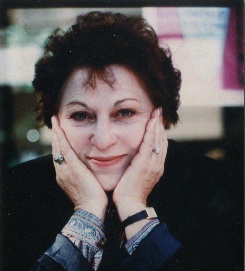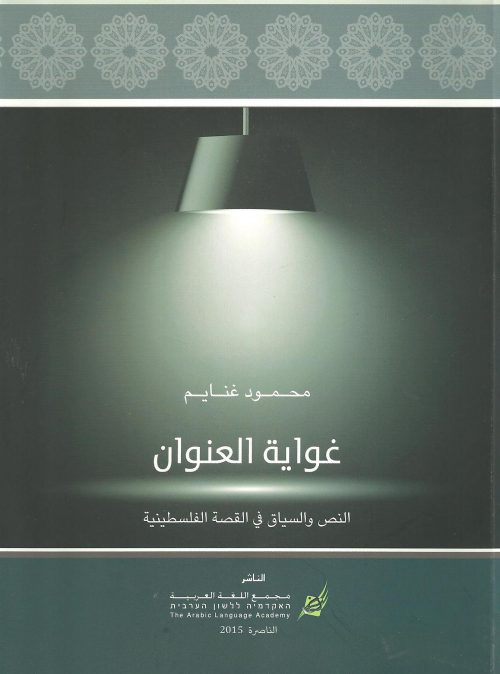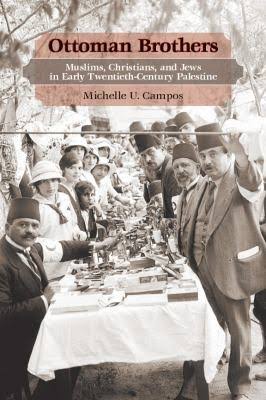-
Add to cartQuick view
Lucia Patrizio Gunning, The British Consular Service in the Aegean and the Collection of Antiquities for the British Museum. Farnham: Ashgate Publishing Ltd., 2009, 224 pp.
Lucia Patrizio Gunning, The British Consular Service in the Aegean and the Collection of Antiquities for the British Museum. Farnham: Ashgate Publishing Ltd., 2009, 224 pp.
$5.00Free!Add to cartQuick view -
Add to cartQuick view
Mahmud Ghanayim. غواية العنوان: النص والسياق في القصة الفلسطينية[The Lure of the Title: Text and Context in Palestinian Fiction, 1948–2012]. Nazareth: The Arabic Language Academy, 2015. 240 pp.
Mahmud Ghanayim. غواية العنوان: النص والسياق في القصة الفلسطينية[The Lure of the Title: Text and Context in Palestinian Fiction, 1948–2012]. Nazareth: The Arabic Language Academy, 2015. 240 pp.
$5.00Free!Add to cartQuick view -
Add to cartQuick view
Masquerade and the Performance of National Imaginaries: Levantine Ethics, Aesthetics, and Identities in Egyptian Cinema
Egyptian films from the 1930s through the 1950s reflected the diversity of Egypt’s cities. This article argues that a subtle but notable shift in the semiotics of otherness—from a Levantine idiom to a less fluid construction of ethno-religious identity—occurs over this period in Egyptian cinema. Analysis of the films Salamah fi khayr [Salama is Fine] and al-cIzz bahdala [Mistreated by Affluence], both released in 1937, reveals what the author identifies as a “Levantine” idiom. These films articulate an ethics of coexistence, adopt a visual language of inclusion, and represent identity as fluid and mutable. Postwar “ethnic comedies” such as Faṭimah wa-Marika wa-Rashil [Fatima, Marika, and Rachel, (1949)] and Ḥasan wa-Murqus wa-Kohayn [Hasan, Marcus, and Cohen (1954)], continue to take Egyptian diversity for granted. However, as this article demonstrates, the characteristics that had defined Levantine cinema—ethics, aesthetics, and fluidity of identity—are no longer present. All the films under discussion treat ethno-religious and national identity as performance. However, that being said, the valences attached to the comic appropriation of an identity not one’s own via role play, assumed identities, and sudden, disorienting class mobility shift over time in nuanced but significant ways. In establishing the idioms of “Levantine cinema” and “ethnic comedies,” this article also takes as a counterpoint the 2008 film Ḥasan wa-Murqus [Hasan and Marcus] which draws upon these earlier Egyptian cinematic traditions in constructing its own discourse of coexistence.
$5.00Free!Add to cartQuick view -
Add to cartQuick view
Michelle U. Campos. Ottoman Brothers: Muslims, Christians and Jews in Early Twentieth-Century Palestine. Stanford: Stanford University Press, 2011. 360 pp.
Michelle U. Campos. Ottoman Brothers: Muslims, Christians and Jews in Early Twentieth-Century Palestine. Stanford: Stanford University Press, 2011. 360 pp.
$5.00Free!Add to cartQuick view -
 Add to cartQuick view
Add to cartQuick viewOn the Question of an Authentic and Original Turkish Literature: Leyla Erbil
Free!This dossier presents three translated essays, by Leyla Erbil (1931–2013), Şavkar Altınel (1953–), and Ataol Behramoğlu (1942–), that inquire into the question of authenticity as related to tradition, individuality, and artistic creativity. The authors try to define what these concepts mean in the Turkish literary field. Prof. Sibel Erol’s essay serves as both an editorial introduction to these translations and an investigation in its own right into the question of whether there is a real Turkish literature. She engages with the heart of the debate through an analysis of the Turkish writer Erbil’s essay titled “On the Question of an Authentic and Original Turkish Literature.” Altınel’s “Yahya Kemal, T. S. Eliot, and the Force of ‘Tradition'” and Behramoğlu’s “Organic Poetry,” while not written directly in response to Erbil’s essay or the question she raises, are in conversation with each other, enriching the debate on literary tradition in general and the state of Turkish literature in particular.
Add to cartQuick view -
Add to cartQuick view
Renegades as Crossover Figures: Forgers of the Early Modern Mediterranean
Free!The early modern Mediterranean world would be incomprehensible without taking into account the key roles of the so-called renegades—converts to Islam—who were far more numerous than converts to Christianity. Since renegades rarely wrote or spoke about themselves except under inquisitorial interrogation, and since most texts of the period portrayed them with hostility, the widest range of sources and discursive genres (including literary) in many languages needs to be examined in order to get some sense of who they were. As frontier protagonists, renegades articulated the cultural and religious divide within the Mediterranean. Models proposing split personalities, antagonistic civilizations, or religious discord have done little to resolve the enigma posed by the renegades in all their heterogeneity. This article questions the emphasis on belief and “sincerity” that has always dominated the discussion of renegades, stressing instead their pragmatism, strategic orientation, and acquired capabilities.
Add to cartQuick view -
Add to cartQuick view
The Burden of Self-Representation: Reflections on Shhur and Its Legacy for Contemporary Mizrahi Films in Israel
Free!In hindsight, Hannah Azulai-Hasfari’s 1995 semi-autobiographical film Shḥur heralded the rise of new Mizrahi cinema—a corpus of contemporary films that features Mizrahi traditions, experiences, and struggle and brings Mizrahi subjectivity to the fore. Given the often uncomplimentary on-screen depiction of the Mizrahi during the formative years of Israeli cinema and the scant Mizrahi self-representation through the early 1990s, one could anticipate the public and scholarly interest in and heightened sensitivity around the elaborate portrayal of the Moroccan family and customs in Azulai-Hasfari’s film. This essay explores the particular modalities of this burden of representation and the strategies the filmmaker employed to unburden herself. Whereas the burden of representation is often situated in the realm of production (the particular directorial choices as they pertain to narrative, cast, space, etc. in the making of a film), the analysis of Shḥur in this essay opts to focus on the modalities along which the burden of representation materializes in the realm of reception. This essay’s final section adumbrates the film’s particular construction of a Mizrahi space as well as its use of languages as devices that left their marks in feature, documentary, short, and experimental Mizrahi films for years afterward. In turn, this more recent crop of Mizrahi films has modified the parameters of the burden of Mizrahi self-representation.
Add to cartQuick view -
Add to cartQuick view
The Imagined Christian Ecumene and the Quest for Return: Christian IDPs in Israel and the 2009 Visit of Benedict XVI
Soliciting transnational Christian authorities, such as the Holy See in Rome, and reaching out to an imagined global Christian ecumene are conventional strategies among Christians in the Middle East in their struggle to obtain benefits and negotiate their minority status at the local level. However, in the case of an internally displaced Greek Catholic village community in Israel—the people of Iqrith—when the quest for return to their destroyed 1948 village brought them into direct contact with the embodied representative of the Catholic ecumene—the pope—the practical goal of return became entangled with a more abstract and perhaps less conspicuous objective. The Christian ecumene became a field of imagination from which the people of Iqrith could challenge the restrictions experienced by Palestinian citizens of Israel and strive for global visibility. In May 2009, Pope Benedict XVI’s visit to Israel provided an opportune occasion for the materialization of an imagined Christian ecumene. This opening field of the imagination offered the people of Iqrith a way of short-circuiting the national, of inscribing the local within the global, and of “re-placing” their village on the imagined map of the world. Expressed from within the Christian ecumene, the quest for return became a means of circumventing Israeli policy and denial regarding their communal past, present, and future and of penetrating what Jean-Loup Amselle has called the “global market of identities.”
$5.00Free!Add to cartQuick view -
Add to cartQuick view
The Making of Palestinian Christian Womanhood: Gender, Class, and Community in Mandate Palestine
This article seeks to expand the study of Palestinian Arab women’s self-identification and social and political activism by examining how Arab Christian women viewed, shaped, and managed their participation in the project of defining Palestinian national identity during the period of British colonial occupation. During the Mandate period, elite Christian women made particular use of mission schools and Christian women’s charitable organizations as platforms for promoting a vision of Palestinian nationalism as modern, nonsectarian, and politically progressive, in hopes of creating a Palestinian national identity in which they could claim a central role. As the Mandate wore on, though, it became increasingly evident that the presentation of Christian women as central to the expression of a broadly based, nonsectarian, modernizing, Westernizing Palestinian national identity was belied somewhat by the communal and class consciousness that education in elite Christian schools and membership in charitable organizations engendered. The way in which this purportedly middle-class, nonsectarian nationalist vision was developed and articulated in highly class- and communally conscious venues ultimately limited its purview and linked it with oppressive colonial practices in the eyes of much of the Palestinian Arab population.
$5.00Free!Add to cartQuick view -
Add to cartQuick view
Tomer Levi, The Jews of Beirut: The Rise of a Levantine Community, 1860s–1930s New York: Peter Lang, 2012. 230 pp.
Tomer Levi, The Jews of Beirut: The Rise of a Levantine Community, 1860s–1930s. New York: Peter Lang, 2012. 230 pp.
$5.00Free!Add to cartQuick view -
Add to cartQuick view
James Bryce’s Blue Book as Evidence
Investigations of the Armenian Genocide began as soon as news of the mass killings reached Great Britain in May 1915. The 1916 publication in Britain of The Treatment of the Armenians in the Ottoman Empire as a Parliamentary Blue Book by Viscount James Bryce provided compelling and verifiable evidence of the systematic elimination of the Armenian population of the Ottoman Empire. Today the Blue Book is largely forgotten as a documentary and historical source on the massacres. This article situates the Blue Book in its historical context, arguing that its publication provided the foundation for the evidentiary standard by which the act of genocide is corroborated and judged by the international community. The uses and abuses of the Blue Book at the time by the British government and the humanitarian movement in making the case for genocide reveal the problematic legacy of the first efforts to catalog and document what the Allies labeled during World War I as “crimes against humanity.”
$5.00Free!Add to cartQuick view -
Add to cartQuick view
A Center of Transnational Syriac Orthodoxy: St. Mark’s Convent in Jerusalem
Free!This article highlights the role of St. Mark’s Convent in Jerusalem as a center of transnational Syriac Orthodoxy. Beginning with Manuel Vásquez’s discussions of transnational religion, it underlines the processual aspect of the transnationalism that characterizes contemporary Syriac Orthodoxy in the Holy Land, as it emerged from a mixture of pilgrimage, genocide, and diaspora as well as the combined forces of ecclesiastical expansion and changing political contexts. A complex web of relationships thus connects the community of Jerusalem to the other Syriac Orthodox groups in Bethlehem and Jordan, to the Syriac Orthodox center in Damascus and Ma‘arat Saydnaya, to the monasteries in Tur Abdin, to the faithful in India, and to the many communities in the diasporas of Europe, the Americas, and Australia. In Jerusalem this network is maintained by a narrative expressed in texts and images that combines the ancient connection to the holy places with the nationalist narrative of the lost homeland, brought together in the profuse use of Classical Syriac, the symbolic language of both church and nation.
While this community in many ways resembles the other small orthodox churches of the Holy Land, especially the Armenian and Ethiopian churches—whose members, like the Syriac Orthodox, tend to see themselves as ethnically different from the majority of local Christians—the Syriac Orthodox differ in that their homeland is a virtual one, existing primarily in the transnational network that ties all the different locations together. In the creation of this virtual homeland, Jerusalem plays a crucial role as the least political, most ecumenical, and most international of all current Syriac Orthodox centers.
Add to cartQuick view
- Home
- About JLS
- Issues
- Vol. 9 No. 1 | Summer 2019
- Vol 8 No 2 Winter 2018
- Vol. 8, No. 1: Summer 2018
- Vol. 7, No. 2: Winter 2017
- Vol. 7, 1: Summer 2017
- Vol. 6, Summer/Winter 2016
- Vol. 5, No. 2 Winter 2015
- Vol. 5, No. 1 Summer 2015
- Vol. 4, No. 2 Winter 2014
- Vol. 4, No. 1 Summer 2014
- Vol. 3, No. 2 Winter 2013
- Vol. 3, No. 1 Summer 2013
- Vol. 2, No. 2 Winter 2012
- Vol. 2, No. 1 Summer 2012
- Vol. 1, No. 2 Winter 2011
- Vol. 1, No. 1 Summer 2011
- Blog
- dock-uments
- Subscribe
- Submit
- Contact





